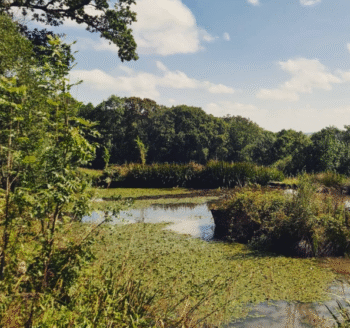Climate-Resilient Wildlife Ponds in Devon & Cornwall
🌍💧 Wildlife Ponds for Climate Resilience: How Ponds Protect Against Floods and Droughts
Climate change is bringing heavier rainfall, longer dry spells, and greater weather extremes to the UK. For landowners, farmers, and local councils in Devon and Cornwall, the question is no longer if these challenges will affect us — but how we adapt.
One of the simplest, most cost-effective, and nature-friendly solutions lies in a feature often overlooked: the wildlife pond.
Why Ponds Matter in a Changing Climate
Wildlife ponds are more than just havens for frogs, dragonflies, and wildflowers. When designed well, they act as natural water-management systems that:
- Soak up heavy rainfall during storms, buffering flood peaks.
- Store water that can be slowly released in dry spells.
- Recharge groundwater, keeping soils productive.
- Filter pollutants, improving water quality downstream.
This makes them powerful tools for climate resilience — helping both people and wildlife.
Ponds as Natural Flood Defences 🌧️
During intense rain, fast runoff from fields, roads, and hard surfaces often rushes straight into rivers, causing flash floods. A well-placed pond:
- Slows water flow, holding stormwater temporarily.
- Spreads water across floodplains instead of sending it downstream in one surge.
- Protects infrastructure by reducing peak flood levels.
Example from Devon
On farmland near the River Otter, landowners have used a network of ponds and scrapes to intercept heavy rain. These ponds hold back thousands of litres of water, reducing the pressure on nearby villages during winter floods.
Ponds as Drought Buffers ☀️
At the other extreme, ponds provide a lifeline in drought:
- Stored water seeps slowly into surrounding soils, maintaining moisture.
- Wildlife refuges: amphibians, insects, and birds rely on ponds when streams dry up.
- Support for farming: pond-fed soils retain more resilience for grazing and crop margins.
Example from Cornwall
In West Cornwall, a farm pond designed as part of an agri-environment scheme has helped sustain amphibians, dragonflies, and cattle alike through recent summer droughts. The water body holds enough depth to persist when seasonal ditches dry, providing resilience for both biodiversity and farm operations.
🌿 Rare Species Supported by Wildlife Ponds in Devon & Cornwall
- Great Crested Newt (Triturus cristatus) – Strictly protected, found in scattered populations across Devon and Cornwall. They need clean, fish-free ponds with plenty of vegetation for breeding.
- Northern Pool Frog (Pelophylax lessonae) – Not currently present in the South West, but projects like Moor Barton are creating the exact pond habitats they require for potential future expansion.
- Marsh Fritillary Butterfly (Euphydryas aurinia) – Relies on damp grasslands and wetland mosaics; ponds enhance habitat connectivity and nectar supply.
- Hairy Dragonfly (Brachytron pratense) – A scarce species in Devon, breeds in well-vegetated ponds with emergent plants such as sedges and rushes.
- Snipe & Lapwing – Both red-listed birds benefit from wet meadows and pond margins for feeding and nesting.
- Otter (Lutra lutra) – Though widespread in Devon and Cornwall, otters thrive where ponds boost fish and amphibian prey.
Wider Benefits 🌿
- Biodiversity boost: Ponds support more species than any other freshwater habitat in Britain.
- Carbon storage: Wetland vegetation and soils trap carbon, helping to offset emissions.
- Community amenity: Well-designed ponds create beautiful, educational spaces for schools and visitors.
- Pollinator support: Flowering marginal plants like water mint, purple loosestrife, and marsh marigold attract bees, butterflies, and hoverflies, boosting pollinator numbers.
- Rare species refuge: Ponds provide crucial breeding and feeding habitats for species such as great crested newts, grass snakes, and declining amphibians like the northern pool frog.
Designing Climate-Resilient Ponds
To maximise climate benefits, ponds should be:
- Shallow-edged: creates habitat for amphibians and plants, and slows water infiltration.
- Varied in depth: deep zones store water in drought; shallow shelves provide wildlife feeding grounds.
- Planted with native species: water mint, brooklime, sedges, and lilies balance ecology and water quality.
- Part of a network: several small ponds are often more effective than one large one.
- Sized appropriately: Even small ponds can deliver climate benefits, but larger ponds provide greater water storage, more diverse habitats, and increased resilience during long dry spells. Ideally, combine ponds of different sizes to create a varied “pondscape.”
- Linked to floodplains and meadows: allowing natural spreading and soaking of water.

Opportunities for Landowners and Councils
In Devon and Cornwall, there are growing opportunities to fund pond creation and restoration:
- ELMS (Environmental Land Management Schemes) reward natural flood management and wetland creation.
- NEIRF (Natural Environment Investment Readiness Fund) supports climate adaptation through nature-based solutions.
- Local AONB and catchment partnerships often provide grants for pond building and restoration.
Conclusion
Wildlife ponds are not just pretty features — they are climate adaptation tools. By buffering floods, storing water in droughts, and boosting biodiversity, they make landscapes across Devon and Cornwall more resilient to change.
For councils, they offer a low-cost, natural alternative to hard engineering. For landowners and farmers, they improve land resilience while attracting wildlife and funding support.
👉 At Sasaquatics, we design and build wildlife ponds across Devon and Cornwall that combine ecological beauty with climate resilience. Get in touch to explore how ponds can protect your land and community.
🌍💧 How Wildlife Ponds Protect Against Flood & Drought
🌧️ Flood Benefits
- Slows water flow: ponds capture storm runoff before it rushes downstream.
- Stores excess rain: temporary holding capacity reduces flood peaks.
- Spreads water safely: reconnects water to floodplains and meadows.
- Protects communities: buffers riverside villages & farmland from flash floods.
☀️ Drought Benefits
- Stores water long-term: deep zones hold water when ditches and streams dry.
- Moisture for soils: slow seepage keeps grassland and crops more resilient.
- Wildlife refuge: amphibians, insects, and birds survive dry spells.
- Supports farming: reliable water source for grazing animals.
Wildlife ponds do double duty: not only buffering climate extremes, but also boosting biodiversity, improving water quality, and storing carbon.
❓ Frequently Asked Questions about Wildlife Ponds & Climate Resilience
How do ponds reduce flooding?
Wildlife ponds capture and hold stormwater during heavy rain, slowing water flow into rivers and reducing flood peaks downstream.
Can ponds help during droughts?
Yes. Ponds store water that slowly seeps into surrounding soils, keeping them moist. They also provide a refuge for wildlife when streams and ditches dry up.
What plants are best for climate-resilient ponds?
Native species such as water mint, brooklime, sedges, and water lilies stabilise pond edges, filter nutrients, and provide food and shelter for wildlife.
Are wildlife ponds eligible for funding in Devon and Cornwall?
Yes. ELMS, NEIRF, and local AONB partnerships offer funding for pond creation, wetland restoration, and natural flood management projects.
Do ponds help with biodiversity as well as climate resilience?
Absolutely. Ponds support more species than any other freshwater habitat in Britain, from amphibians and dragonflies to birds and bats.






